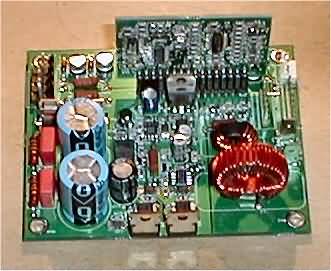|
Class-D history.
The
basic theory behind pwm amplifiers (or Class-D amplifiers) has been known for 30
years or so, so its not a new invention as "some" would like
you to believe ;)
Power amplifiers are divided into various classes from the
way the output stage works, like Class-A, Class-B etc. Some call
class-d for digital amplifiers, we think a digital amplifier shall
have a digital input and preferably digital pwm generation to be
called a "digital amplifier".
Clive Sinclair had a 10W class-d hifi amplifier kit in the early 70´s and
Harris released application notes + evaluation boards for a 200W
class-d amplifier in 1995, these are the core background for many
class-d amplifiers of today.
Class-D
topologies.
Basically
you can define a class-d amplifier as a clock based design or a
self-oscillating design. The clock based version has a clock
(typically 250 - 400 kHz) which is fed as a triangle signal to a
comparator and the pwm is amplified with an output stage , the high
frequency clock is filtered out by an output filter and the amplified
audio signal remains.
A
self-oscillating design uses an opamp as an integrator and the clock
is made by feedback from the output and the whole amp oscillates , the
clock is again filtered out and the amplified audio signal remains.
Both
versions can have feedback before the output filter or after the
output filter, some seem to think it doesnt matter a lot which
topology you choose, we think feedback after the output filter is much
better and should be preferred.
Both
the clock based and the self oscillating amplifier can be half-bridge
or full bridge design, meaning the half bridge will have one pair of
output fets and output from these to midpoint of the power supply, the
full-bridge will have 2 pairs of output fets (in opposite phase) and
output between the midpoints of these 2 pairs.
Half
bridge designs are often more sensitive to power supply regulation and
shortcomings , the fullbridge design will normally have a higher power
supply rejection and is less prone to power supply pumping as
well.
Sound
quality and specs.
Several examples of bad designed class-d amplifiers have been around
and in the last years new types have been brought to market , some of them
designed to give good steady-state distorsion figures (with
not-so-good sound quality) and others just barely working , with lots
of problems with EMC, radio reception... and again far from HIFI sound
quality.
To design and produce a pwm amplifier with HIFI sound quality , high
power and very high efficiency isnt easy at all, there are many
demanding and conflicting design tasks.
If you focus mainly on thd specs you are likely to end up with
an amplifier having good thd specs unfortunately this isnt at
all the same as having a good sound quality , basically you can
see the old linear amplifiers with very high negative feedback
and you can compare the sound quality from these with amplifiers
being designed with superior sound quality in mind. Many
featurers of linear amplifiers can of course be adapted by
class-d/pwm amplifiers too, like balanced inputs , DC-servo ,
protection schemes, etc.
Multicannel
amplifiers and sync.
In
a multichannel amplifier you would want the channels to be in
sync to avoid beating an other undesired effects, this isnt easy
achieved with many of the self-oscillation designs but much
easier with a clock based design as you can use a "master
clock" and slave all amplifier channels with the same
clock, this way they are effectively in sync.
Power
supply.
For
most domestic applications a high quality linear power supply ,
a toroidal transformer, high speed diodes and low esr
electrolytic capacitors + regulated power supply for input and
driver circuitry will work just fine. For mobile applications or
other low weight applications or small size you can choose a
switch-mode power supply to power you class-d amplifier, here
are a couple of pitfalls, as mentioned above some class-d
amplifiers do not at all like being powered with a smps, some of
the selfosc. designs seem to pick up the clock from the smps and
some of them counteract with the feedback loop of the smps
giving a completely unstable system alltogether.
So
please make sure your amplifier works well with a switch mode
supply or buy the amplifier + smps as an integrated unit, this
should guarantee they work together without problems.
Karsten
Madsen - CAD Audio DK - june 2007

|